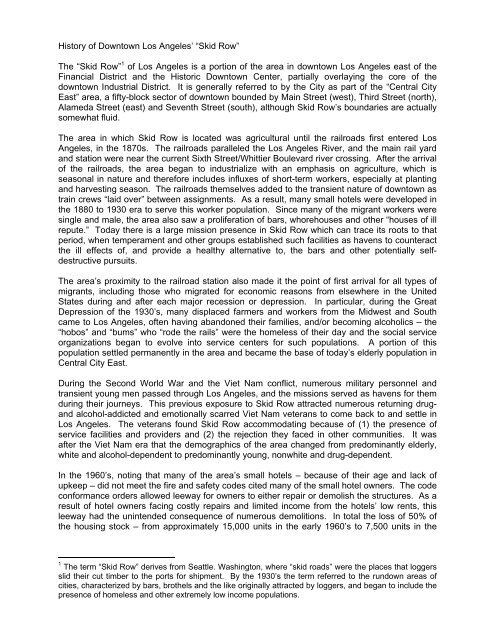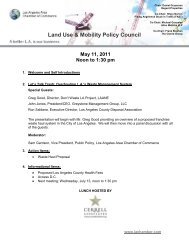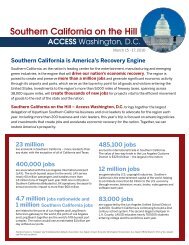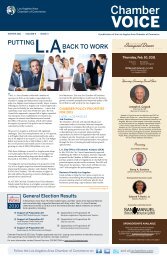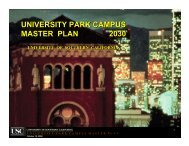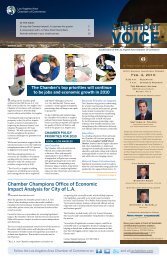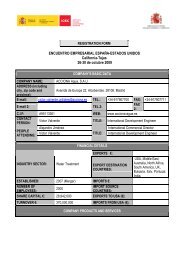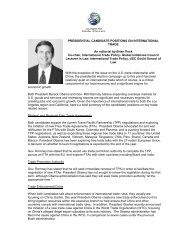Skid Row - Los Angeles Chamber of Commerce
Skid Row - Los Angeles Chamber of Commerce
Skid Row - Los Angeles Chamber of Commerce
You also want an ePaper? Increase the reach of your titles
YUMPU automatically turns print PDFs into web optimized ePapers that Google loves.
History <strong>of</strong> Downtown <strong>Los</strong> <strong>Angeles</strong>’ “<strong>Skid</strong> <strong>Row</strong>”<br />
The “<strong>Skid</strong> <strong>Row</strong>” 1 <strong>of</strong> <strong>Los</strong> <strong>Angeles</strong> is a portion <strong>of</strong> the area in downtown <strong>Los</strong> <strong>Angeles</strong> east <strong>of</strong> the<br />
Financial District and the Historic Downtown Center, partially overlaying the core <strong>of</strong> the<br />
downtown Industrial District. It is generally referred to by the City as part <strong>of</strong> the “Central City<br />
East” area, a fifty-block sector <strong>of</strong> downtown bounded by Main Street (west), Third Street (north),<br />
Alameda Street (east) and Seventh Street (south), although <strong>Skid</strong> <strong>Row</strong>’s boundaries are actually<br />
somewhat fluid.<br />
The area in which <strong>Skid</strong> <strong>Row</strong> is located was agricultural until the railroads first entered <strong>Los</strong><br />
<strong>Angeles</strong>, in the 1870s. The railroads paralleled the <strong>Los</strong> <strong>Angeles</strong> River, and the main rail yard<br />
and station were near the current Sixth Street/Whittier Boulevard river crossing. After the arrival<br />
<strong>of</strong> the railroads, the area began to industrialize with an emphasis on agriculture, which is<br />
seasonal in nature and therefore includes influxes <strong>of</strong> short-term workers, especially at planting<br />
and harvesting season. The railroads themselves added to the transient nature <strong>of</strong> downtown as<br />
train crews “laid over” between assignments. As a result, many small hotels were developed in<br />
the 1880 to 1930 era to serve this worker population. Since many <strong>of</strong> the migrant workers were<br />
single and male, the area also saw a proliferation <strong>of</strong> bars, whorehouses and other “houses <strong>of</strong> ill<br />
repute.” Today there is a large mission presence in <strong>Skid</strong> <strong>Row</strong> which can trace its roots to that<br />
period, when temperament and other groups established such facilities as havens to counteract<br />
the ill effects <strong>of</strong>, and provide a healthy alternative to, the bars and other potentially selfdestructive<br />
pursuits.<br />
The area’s proximity to the railroad station also made it the point <strong>of</strong> first arrival for all types <strong>of</strong><br />
migrants, including those who migrated for economic reasons from elsewhere in the United<br />
States during and after each major recession or depression. In particular, during the Great<br />
Depression <strong>of</strong> the 1930’s, many displaced farmers and workers from the Midwest and South<br />
came to <strong>Los</strong> <strong>Angeles</strong>, <strong>of</strong>ten having abandoned their families, and/or becoming alcoholics – the<br />
“hobos” and “bums” who “rode the rails” were the homeless <strong>of</strong> their day and the social service<br />
organizations began to evolve into service centers for such populations. A portion <strong>of</strong> this<br />
population settled permanently in the area and became the base <strong>of</strong> today’s elderly population in<br />
Central City East.<br />
During the Second World War and the Viet Nam conflict, numerous military personnel and<br />
transient young men passed through <strong>Los</strong> <strong>Angeles</strong>, and the missions served as havens for them<br />
during their journeys. This previous exposure to <strong>Skid</strong> <strong>Row</strong> attracted numerous returning drugand<br />
alcohol-addicted and emotionally scarred Viet Nam veterans to come back to and settle in<br />
<strong>Los</strong> <strong>Angeles</strong>. The veterans found <strong>Skid</strong> <strong>Row</strong> accommodating because <strong>of</strong> (1) the presence <strong>of</strong><br />
service facilities and providers and (2) the rejection they faced in other communities. It was<br />
after the Viet Nam era that the demographics <strong>of</strong> the area changed from predominantly elderly,<br />
white and alcohol-dependent to predominantly young, nonwhite and drug-dependent.<br />
In the 1960’s, noting that many <strong>of</strong> the area’s small hotels – because <strong>of</strong> their age and lack <strong>of</strong><br />
upkeep – did not meet the fire and safety codes cited many <strong>of</strong> the small hotel owners. The code<br />
conformance orders allowed leeway for owners to either repair or demolish the structures. As a<br />
result <strong>of</strong> hotel owners facing costly repairs and limited income from the hotels’ low rents, this<br />
leeway had the unintended consequence <strong>of</strong> numerous demolitions. In total the loss <strong>of</strong> 50% <strong>of</strong><br />
the housing stock – from approximately 15,000 units in the early 1960’s to 7,500 units in the<br />
1 The term “<strong>Skid</strong> <strong>Row</strong>” derives from Seattle. Washington, where “skid roads” were the places that loggers<br />
slid their cut timber to the ports for shipment. By the 1930’s the term referred to the rundown areas <strong>of</strong><br />
cities, characterized by bars, brothels and the like originally attracted by loggers, and began to include the<br />
presence <strong>of</strong> homeless and other extremely low income populations.
early 1970’s – contributed to the displacement <strong>of</strong> a significant number <strong>of</strong> extremely low-income,<br />
substance dependent and/or mentally unstable persons who had settled in Central City East.<br />
In 1975, the area became part <strong>of</strong> the then newly adopted Central Business District<br />
Redevelopment Project Area. A Blue Ribbon Committee comprised <strong>of</strong> civic leaders, business<br />
persons and academics established shortly after adoption <strong>of</strong> the Project Area issued a report in<br />
1976 calling for the preservation <strong>of</strong> the remaining housing stock and other steps to address the<br />
social, economic and medical problems <strong>of</strong> the downtown population. As a result, <strong>Los</strong> <strong>Angeles</strong><br />
embarked on a program <strong>of</strong> acquiring, rehabilitating and managing the remaining single-roomoccupancy<br />
hotel units and adding a limited number <strong>of</strong> community amenities, most notably two<br />
vest-pocket parks, clinics and shelter facilities. To date, roughly 3,500 <strong>of</strong> the surviving 6,500<br />
single-room-occupancy units have been acquired and rehabilitated or replaced. Another<br />
unintended consequence <strong>of</strong> the City’s action, however, has been that other communities were<br />
then able not to provide for their own social needs, but rather shipped their homeless and<br />
problem populations to downtown <strong>Los</strong> <strong>Angeles</strong>.<br />
The area <strong>of</strong> these small hotels, missions and shelters is also characterized by numerous<br />
industrial, warehousing and distribution activities. This local manufacturing, processing and<br />
wholesale sector <strong>of</strong> the economy, which also dates to the coming <strong>of</strong> the railroads, has been<br />
growing significantly; a sharp contrast to the sluggish performance <strong>of</strong> other sectors <strong>of</strong> the<br />
economy on the national level. Because many <strong>of</strong> these businesses are small, <strong>of</strong>ten run by<br />
immigrants and employing low-skilled workers who do not have transportation options, these<br />
businesses need to remain close to the City’s core. As they expand, however, they put<br />
pressure on the limited housing stock in the area, raising the specter <strong>of</strong> additional loss <strong>of</strong> the<br />
area’s very low cost housing stock. In addition, many <strong>of</strong> the businesses are food-based, which<br />
engenders serious public health problems in a dense area with a large street population lacking<br />
access to sanitary facilities.<br />
Moreover, while throughout most <strong>of</strong> its history the area’s population has been predominantly<br />
single and male, the recession <strong>of</strong> the 1990’s resulted in many middle class families breaking up,<br />
with both single adults on their own and single adults (mostly women) with children arriving in<br />
<strong>Skid</strong> <strong>Row</strong> and in need <strong>of</strong> shelter and other assistance.<br />
Today the Central City East area, including <strong>Skid</strong> <strong>Row</strong>, contains a population <strong>of</strong> approximately<br />
12,000 persons. Approximately 8,000 <strong>of</strong> them live permanently or semi-permanently in the<br />
6,500 single-room-occupancy hotel rooms and approximately 2,000 persons occupy beds in<br />
shelter and transitional facilities, for periods <strong>of</strong> time ranging from days to several months. The<br />
population living on the streets is variously estimated by the <strong>Los</strong> <strong>Angeles</strong> Homeless Services<br />
Authority, the <strong>Los</strong> <strong>Angeles</strong> Police Department and others, and numbers are estimated to range<br />
from 2,000 to 4,500 or 5,000 persons, with the numbers changing both seasonally and<br />
throughout the month. While the population is still predominantly made <strong>of</strong> up single males,<br />
there are increasing numbers <strong>of</strong> women and children, now pushing five to ten percent <strong>of</strong> the<br />
total population on <strong>Skid</strong> <strong>Row</strong>.<br />
With the increasing popularity <strong>of</strong> communities surrounding Central City East for middle- and<br />
upper-income housing, along with the pressure for expansion <strong>of</strong> local industries, there are<br />
concerns for the potential for some <strong>of</strong> the <strong>Skid</strong> <strong>Row</strong> housing to be displaced. As a result, it is<br />
becoming increasingly important to identify mechanisms to deal with – and, hopefully, solve –<br />
chronic homelessness in <strong>Los</strong> <strong>Angeles</strong>.
Downtown <strong>Los</strong> <strong>Angeles</strong> <strong>Skid</strong> <strong>Row</strong> Street<br />
Scene<br />
“<strong>Skid</strong> <strong>Row</strong>”
Downtown <strong>Los</strong> <strong>Angeles</strong> <strong>Skid</strong> <strong>Row</strong> Street Scene<br />
Example <strong>of</strong> a rehabilitated Single-Room-<br />
Occupancy Hotel in <strong>Skid</strong> <strong>Row</strong><br />
Downtown <strong>Los</strong> <strong>Angeles</strong> <strong>Skid</strong> <strong>Row</strong> Street Scene<br />
Jim Wood Center at 5 th and San Julian Streets, a<br />
social service facility in Central City East close to<br />
the largest concentration <strong>of</strong> residential hotels


